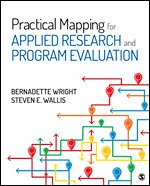Evaluation Q & A with Wright & Wallis
Bernadette Wright and Steve Wallis, co-authors of the book Practical Mapping for Applied Research and Program Evaluation, served as Mentors-in-residence for SAGE MentorSpace in October 2019. They agreed to answer some questions. This is the first of four Q & A posts.
Your book site offers a sample syllabus and teacher’s guide. What kinds of courses or programs might use these options? Any suggestions for adopting these methods for teaching and learning?
We are very excited about the benefits of practical mapping for student learning as well as for planning and program development for our clients. We are proud to be contributing members of the dynamic and expanding field where professionals work together to improve planning, policy, and service delivery to improve the human condition.
In addition to writing the book, we’ve also developed several resources, available on the book website, including a teacher’s guide and syllabus.
In this post, we’ll tell you how those resources may be useful to you.
First – And, perhaps, most obviously, if you are a college or graduate school professor, you may want to use these resources in your courses. The book makes a great secondary text for a variety of courses with a research methods component, including courses in public policy, program evaluation, sociology, education, and many other subjects. It also makes a great primary text if you want to teach a course on the fundamentals of social research and/or evaluation.Krisanna Machtmes of Ohio University said in a review: “..As an evaluator who works with community members and teaches evaluation at the graduate level, I will use this book as the ‘go-to resource’ for developing maps that can solve complex problems. This book uses a collaborative approach to mapping that can be used in all areas of research.”
Second – You can also use the materials to teach a new class if you’re interested in becoming a teacher at your local university or community college. Colleges generally have a process where you can submit a proposal to teach a course; or, a series of weekend classes.
Third – You may want to teach a series of classes within your workplace. This is a great way to share your understanding of the field with others. Even if they do little (or no) research, they will gain a greater appreciation for what you do (and, you may discover some hidden talent and interest).
Fourth – You can use relevant sections of the teaching guide and syllabus as inspirations to set up classes that are part of your local professional association chapter (American Evaluation Association, or another group). You might talk with the activities chair (or whoever sets up the meetings) to identify one or more activities that chapter members might find especially useful (interviewing techniques, practical mapping, data analysis, etc.).


